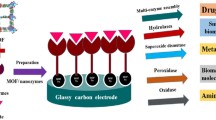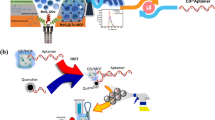Abstract
An electrostatically controlled fluorometric assay is described that is based on the use of silver/copper bimetallic nanoclusters. The nanoclusters were coated with polyethyleneimine (PEI-Ag/CuNCs). At pH 7.4, these particles are positively charged. Their blue fluorescence (with excitation/emission peaks at 341/464 nm) depends on local pH values and temperature. If graphene oxide (which is negatively charged at pH 7.4) is introduced, the fluorescence of the PEI-Ag/CuNCs is quenched. Based on various electrostatic interactions, three kinds of biomacromolecules were detected by fluorometry. These include (negatively charged) heparin, (positively charged) protamine, and (virtually uncharged) trypsin. Heparin is detected by using GO/PEI-Ag/CuNCs, protamine by using GO/heparin/PEI-Ag/CuNCs, and trypsin by using GO/protamine/heparin/PEI-Ag/CuNC. The detection limits and linear ranges are 4.8 nM and 10–450 nM for heparin, 0.09 μg·mL−1 and 0.25–5 μg·mL−1 for protamine, and 0.03 μg·mL−1 and 0.05–1 μg·mL−1 for trypsin. Zeta potentials of the various substances in the system were determined to elucidate the detection mechanism. Comceivably, the method provides a widely applicable approach for electrostatically controlled biomolecular assays.

Schematic presentation of electrostatically controlled fluorometric assay for the detection of heparin, protamine, and trypsin based on the silver/copper bimetallic nanoclusters modified with polyethyleneimine and graphene oxide.







Similar content being viewed by others
References
Chen LJ, Ren YY, Wu NW, Sun B, Ma JQ, Zhang L, Tan H, Liu M, Li X, Yang HB (2015) Hierarchical self-assembly of discrete organoplatinum(II) metallacycles with polysaccharide via electrostatic interactions and their application for heparin detection. J Am Chem Soc 137:11725–11735
Lee DN, Bae S, Han K, Shin IS, Kim SK, Hong JI (2017) Electrostatic modification for promotion of flavin-mediated oxidation of a probe for flavin detection. Chem Eur J 23:16078–16084
Wu Y, Huang S, Zeng F, Wang J, Yu C, Huang J, Xie H, Wu S (2015) A ratiometric fluorescent system for carboxylesterase dtection with AIE dots as FRET donors. Chem Commun 51:12791–12794
Fan X, Zhang D, Li H, Sun S, Xu Y (2017) A BSA-squaraine hybrid system for selectively detecting ag+ in absolute PBS and sequential construction of logic functions. Sensors Actuators B Chem 245:290–296
Jiang G, Wang J, Yang Y, Zhang G, Liu Y, Lin H, Zhang G, Li Y, Fan X (2016) Fluorescent turn-on sensing of bacterial lipopolysaccharide in artificial urine sample with sensitivity down to nanomolar by tetraphenylethylene based aggregation induced emission molecule. Biosens Bioelectron 85:62–67
Liu J, Liu G, Liu W, Wang Y, Xu M, Wang B (2016) Turn-on fluorometric β-carotene assay based on competitive host-guest interaction between rhodamine 6G and β-carotene with a graphene oxide functionalized with a β-cyclodextrin-modified polyethyleneimine. Microchim Acta 183:1161–1168
Liu G, Huang X, Zheng S, Li L, Xu D, Xu X, Zhang Y, Lin H (2018) Novel triadimenol detection assay based on fluorescence resonance energy transfer between gold nanoparticles and cadmium telluride quantum dots. Dyes Pigments 149:229–235
Xie H, Bei F, Hou J, Ai S (2018) A highly sensitive dual-signaling assay via inner filter effect between g-C3N4 and gold nanoparticles for organophosphorus pesticides. Sensors Actuators B Chem 55:2232–2239
Zhang Y, Li Y, Zhang C, Zhang Q, Huang X, Yang M, Shahzad SA, Lo KK, Yu C, Jiang S (2017) Fluorescence turn-on detection of alkaline phosphatase activity based on controlled release of PEI-capped cu nanoclusters from MnO2 nanosheets. Anal Bioanal Chem 409:4771–4778
Chen J, Liao D, Wang Y, Zhou H, Li W, Yu C (2013) Real-time fluorometric assay for acetylcholinesterase activity and inhibitor screening through the pyrene probe monomer-excimer transition. Org Lett 15(9):2132–2135
Hu Q, Zeng F, Wu S (2016) A ratiometric fluorescent probe for hyaluronidase detection via hyaluronan-induced formation of red-light emitting excimers. Biosens Bioelectron 79:776–783
Fang J, Zhang B, Yao Q, Yang Y, Xie J, Yan N (2016) Recent advances in the synthesis and catalytic applications of ligand-protected, atomically precise metal nanoclusters. Coord Chem Rev 322:1–29
Yue D, Wang M, Deng F, Yin W, Zhao H, Zhao X, Xu Z (2018) Biomarker-targeted fluorescent probes for breast cancer imaging. Chinese Chem Lett 29:648–656
Zhou TY, Lin LP, Rong MC, Jiang YQ, Chen X (2013) Silver-gold alloy nanoclusters as a fluorescence-enhanced probe for aluminum ion sensing. Anal Chem 85:9839–9844
Yao Q, Feng Y, Fung V, Yu Y, Jiang DE, Yang J, Xie J (2017) Precise control of alloying sites of bimetallic nanoclusters via surface motif exchange reaction. Nat Commun 8:1555
Wang C, Cheng H, Sun Y, Xu Z, Lin H, Lin Q, Zhang C (2014) Nanoclusters prepared from a silver/gold alloy as a fluorescent probe for selective and sensitive determination of lead(II). Microchim Acta 182:695–701
Zhang N, Si Y, Sun Z, Chen L, Li R, Qiao Y, Wang H (2014) Rapid, selective, and ultrasensitive fluorimetric analysis of mercury and copper levels in blood using bimetallic gold-silver nanoclusters with "silver effect"-enhanced red fluorescence. Anal Chem 86:11714–11721
Sun J, Yang F, Zhao D, Chen C, Yang X (2015) Integrated logic gate for fluorescence turn-on detection of histidine and cysteine based on ag/au bimetallic nanoclusters-Cu2+ ensemble. ACS Appl Mater Interfaces 7:6860–6866
Li W, Li W, Hu Y, Xia Y, Shen Q, Nie Z, Huang Y, Yao S (2013) A fluorometric assay for acetylcholinesterase activity and inhibitor detection based on DNA-templated copper/silver nanoclusters. Biosens Bioelectron 47:345–349
Mehta PK, Lee H, Lee KH (2017) Highly sensitive ratiometric detection of heparin and its oversulfated chondroitin sulfate contaminant by fluorescent peptidyl probe. Biosens Bioelectron 91:545–552
Rao H, Ge H, Wang X, Zhang Z, Liu X, Yang Y, Liu Y, Liu W, Zou P, Wang Y (2017) Colorimetric and fluorometric detection of protamine by using a dual-mode probe consisting of carbon quantum dots and gold nanoparticles. Microchim Acta 184:3017–3025
Kim D, Kim J, Lee TS (2018) Dual-signal detection of trypsin using controlled aggregation of conjugated polymer dots and magnetic nanoparticles. Sensors Actuators B Chem 264:45–51
Liu Q, Lai Q, Li N, Su X (2018) Copper nanoclusters capped with tannic acid as a fluorescent probe for real-time determination of the activity of pyrophosphatase. Microchim Acta 185:182
Liu C, Ding Y, Li Q, Lin Y (2017) Photochemical synthesis of glutathione-stabilized silver nanoclusters for fluorometric determination of hydrogen peroxide. Microchim Acta 184:2497–2503
Huang X, Shahzad SA, Li Y, Zhang Y, Sang L, Zhou H, Jiang H, Kam-Wing Lo K, Yu C (2017) Silver nanoclusters capped silica nanoparticles as a ratiometric photoluminescence nanosensor for the selective detection of I− and S2−. Anal Chim Acta 988:74–80
Liu ZC, Qi JW, Hu C, Zhang L, Song W, Liang RP, Qiu JD (2015) Cu nanoclusters-based ratiometric fluorescence probe for ratiometric and visualization detection of copper ions. Anal Chim Acta 895:95–103
Qu F, Zou X, Kong R, You J (2016) A tunable pH-sensing system based on ag nanoclusters capped by hyperbranched polyethyleneimine with different molecular weights. Talanta 146:549–555
Kong L, Chu X, Wang C, Zhou H, Wu Y, Liu W (2018) D-penicillamine-coated cu/ag alloy nanocluster superstructures: aggregation-induced emission and tunable photoluminescence from red to orange. Nanoscale 10:1631–1640
Xiong H, Wang W, Liang J, Wen W, Zhang X, Wang S (2017) A convenient purification method for metal nanoclusters based on pH-induced aggregation and cyclic regeneration and its applications in fluorescent pH sensors. Sensors Actuators B Chem 239:988–992
Qu F, Li NB, Luo HQ (2013) Highly sensitive fluorescent and colorimetric pH sensor based on polyethylenimine-capped silver nanoclusters. Langmuir 29:1199–1205
Lan J, Zou H, Liu Z, Gao M, Chen B, Li Y, Huang C (2015) A visual physiological temperature sensor developed with gelatin-stabilized luminescent silver nanoclusters. Talanta 143:469–473
Sailapu SK, Sahoo AK, Ghosh SS, Chattopadhyay A (2014) Hierarchical logic structures based on responsive fluorescent gold nanoclusters. Small 10:4067–4071
Zu F, Yan F, Bai Z, Xu J, Wang Y, Huang Y, Zhou X (2017) The quenching of the fluorescence of carbon dots: a review on mechanisms and applications. Microchim Acta 184:1899–1914
Ling Y, Gao ZF, Zhou Q, Li NB, Luo HQ (2015) Multidimensional optical sensing platform for detection of heparin and reversible molecular logic gate operation based on the phloxine B/polyethyleneimine system. Anal Chem 87:1575–1581
Cai L, Zhan R, Pu KY, Qi X, Zhang H, Huang W, Liu B (2011) Butterfly-shaped conjugated oligoelectrolyte/graphene oxide integrated assay for light-up visual detection of heparin. Anal Chem 83:7849–7855
Chen H, Fang A, Zhang Y, Yao S (2017) Silver triangular nanoplates as an high efficiently FRET donor-acceptor of upconversion nanoparticles for ultrasensitive "turn on-off" protamine and trypsin sensor. Talanta 174:148–155
Acknowledgements
The project was supported by State Key Laboratory of Inorganic Synthesis and Preparative Chemistry, College of Chemistry, Jilin University, China (2019-4).
Author information
Authors and Affiliations
Corresponding author
Ethics declarations
The author(s) declare that they have no competing interests.
Additional information
Publisher’s Note
Springer Nature remains neutral with regard to jurisdictional claims in published maps and institutional affiliations.
Electronic supplementary material
ESM 1
(DOCX 1416 kb)
Rights and permissions
About this article
Cite this article
Yang, J., Song, N. & Jia, Q. Electrostatically controlled fluorometric assay for differently charged biotargets based on the use of silver/copper bimetallic nanoclusters modified with polyethyleneimine and graphene oxide. Microchim Acta 186, 70 (2019). https://doi.org/10.1007/s00604-018-3179-6
Received:
Accepted:
Published:
DOI: https://doi.org/10.1007/s00604-018-3179-6




